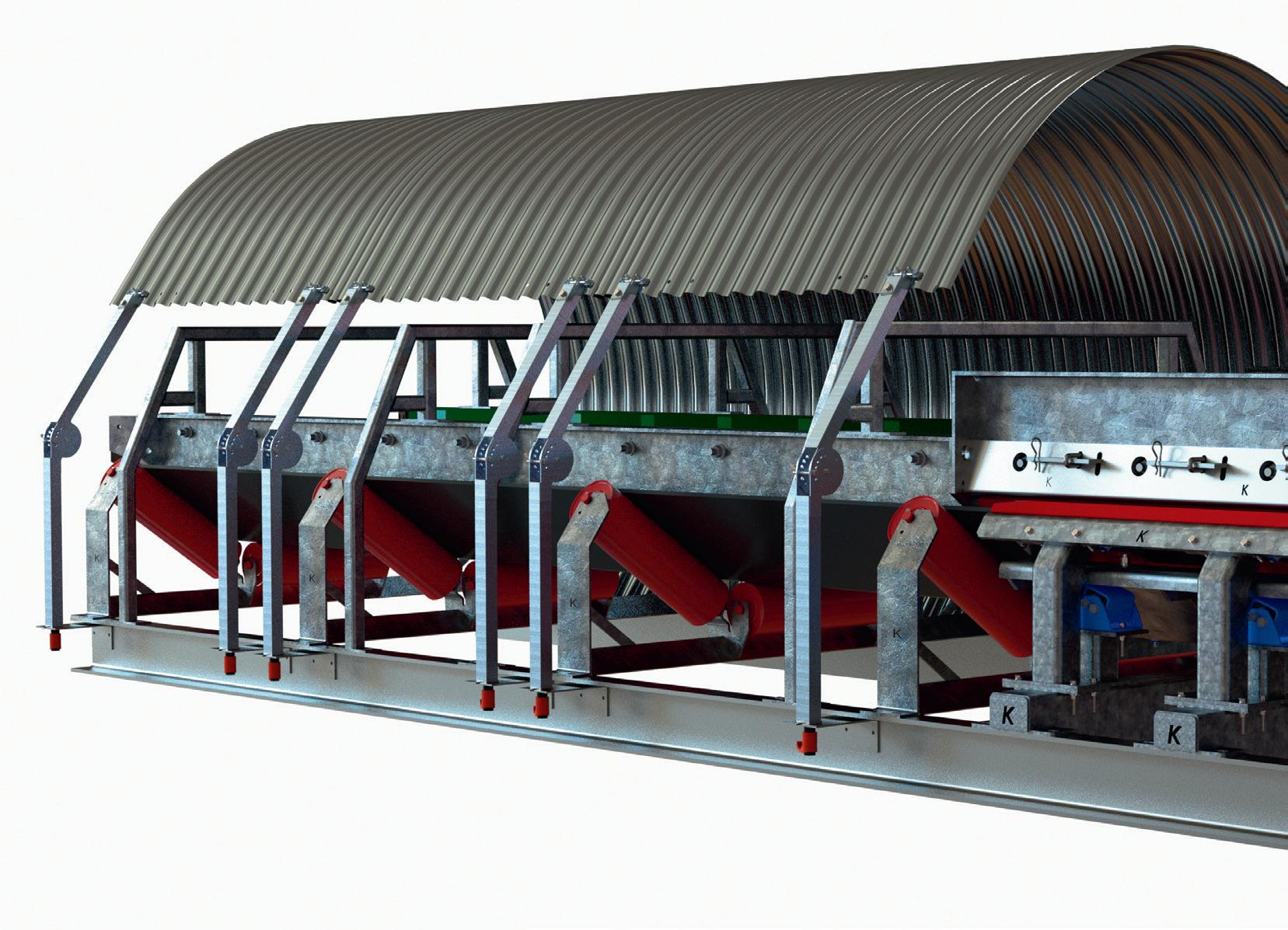
5 minute read
Using conveyor covers to reduce dust and enhance safety
Conveyor belts can be used to convey a variety of bulk materials; in the process, they are exposed to constant and unrelenting environmental conditions, such as extreme wind, precipitation, heat and humidity. This can damage the conveyor belt and its conveyed materials. The harsh conditions conveyor belts are exposed to can lead to the issues of material runback and damaging material spillage, having negative impacts to productivity targets and operational bottom lines. Selecting and installing the correct conveyor belt cover for specific applications and environmental exposure is critical. For applications where a consistent and high-quality finished product is imperative, conveyor belt covers act as protective barriers.
Keeping conveyor belts completely covered with the use of conveyor covers results in less wear on critical high-performance conveyor components and the conveyor belt itself. Due to the overall reduced weight of installed conveyor components, protection provided from the conveyor belt covers can improve the service life of the conveyor hardware and the conveyor belt.
Dust becomes a concern when it becomes fugitive and airborne, increasing costs along every step in the production process. There are also the ongoing costs and additional maintenance resources allocated to cleaning up dust and personal protective equipment required by workers when dust is not contained effectively. Many operators have turned to conveyor belt covers as an economical, effective and safe solution for dust containment and airborne dust reduction. By covering up conveyor belts, the chance of dust emissions going outside the boundaries and negatively impacting nearby residents, communities and ecosystems is minimised and the health and longevity of these communities remains intact. The ability to suppress dust emissions makes conveyor belt covers an asset to the conveyor and a useful OHS implement. Uncontained, excessive dust in the air leaves operators exposed to potential health hazards. Long-term inhalation of dust can lead to potentially irreversible lung damage and diseases such as silicosis.
Durability, lightweight, aero-dynamic materials and ease of maintenance access are important aspects to look for when considering which conveyor belt cover is suitable. Conveyor belt covers can be designed and manufactured using a range of high-performance materials including galvanised steel, pre-lacquered steel, stainless steel and aluminium, and fibre-reinforced polyester. From these engineered materials, conveyor belt covers can be designed for any size, shape and application, as well as to suit the varying extremes of weather that the conveyor belt is exposed to and the level of protection required.
Traditional conveyor belt covers are high strength and versatile, shielding the entire conveyor belt from all weather conditions and suppressing dust emissions. Some also feature a lock/hinge system, which is designed to withstand the extremities of heat, wind, humidity and precipitation over long periods. Conveyor covers that are hinged on both sides provide ongoing access and simple maintenance from both sides of the conveyor. Like conveyor covers, service props and struts also come in varying designs, shapes and sizes. These tools allow operators to gain access inside the cover to conduct routine maintenance. Service props are fully adjustable systems that hold up the conveyor belt cover safely and securely, enabling maintenance inside the covers to be performed easily. Conveyor covers are designed to provide protection from nature’s harsh elements, while also keeping materials contained within.
CASE
STUDY Using wearable sensors to enhance safety and reduce injury
©stock.adobe.com/au/Photographee.eu

A leading manufacturer identified the role of moulding as being at “high risk” of musculoskeletal injuries, as it inherently involves demanding postures unique to this role. Keen to address the manual handling requirements of this role, Jonesco (Preston) Ltd utilised dorsaVi’s technology to assess the role of Moulding and gain objective data to inform and reduce the risk of manual handling injuries. During the consultative session with dorsaVi, the team scoped the baseline assessment of the Moulder’s dayto-day tasks, as well as some specific comparative tasks. Jonesco broke down the key components of the role of Moulding, focusing on dexterous and heavy tasks, to isolate four areas which needed focus. These included XTB with and without Frekote (a versatile release agent), transferring the polymer, and one person versus two person demoulding.
During the onsite assessment, dorsaVi’s wearable sensors were attached to a Moulder who completed tasks within these four areas. The sensor captured the Moulder’s back and shoulder movements, including lumbar flexion, trunk inclination, pelvic angle (back), upper arm elevations (shoulders), and electro-muscular activity (back and shoulders). The dorsaVi assessor also used video throughout the assessment. To analyse the data, the sensor readings were synchronised with video footage to measure the postural and muscle activity risk factors. Utilising the data from the ViSafe assessment, Jonesco were able to implement some key practical changes for the role of Moulding. These included validating the benefits of using Frekote in reducing manual handling risk and updating their Standard Operating Procedures accordingly. Jonesco also investigated other similar products (such as using cooling agents) to reduce the manual handling risk and implemented conversations internally to identify alternative equipment and processes for transferring heavy materials to the moulds to reduce shoulder demand. Jonesco also implemented myViSafe small sensor and app technology to train and coach employees in best-practice manual handling techniques to drive behaviour change.
Overall, the objective data and results showed that the Moulder’s shoulders consistently scored a higher Movement Risk Score (MRS) than the back; due to the repetitive nature of the tasks, the large and awkward equipment utilised and the work environment, the Moulder was repetitively moving their shoulders into higher risk amber and red zones, indicating that this should be a focus for interventions and control strategies. Using XTB with Frekote reduced the overall MRS by 37.5% and improved efficiency by 65% (when compared to XTB without Frekote).
Using the ViSafe assessment, Jonesco gained insights into the role of Moulding, allowing the company to prioritise investments to maximise employee health and safety. With objective, visual data, management and employees had a clearer view of manual handling risks associated with certain jobs and a data-driven path to improve both behaviour and outcomes. dorsaVi Pty Ltd www.dorsavi.com









